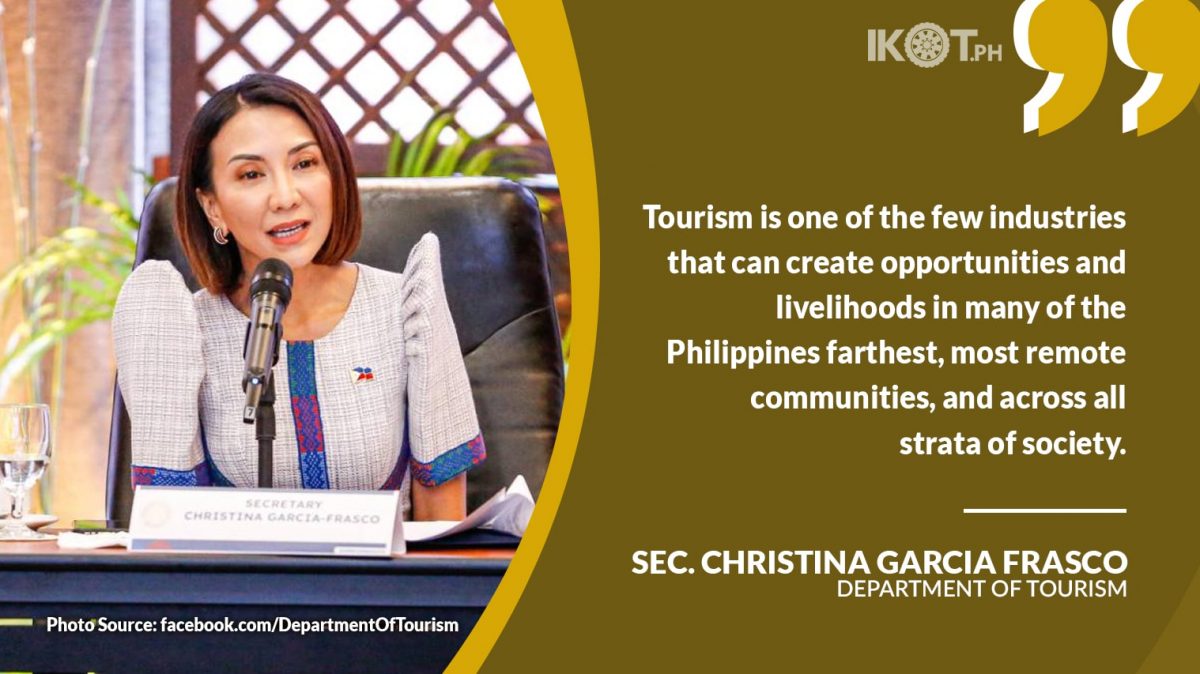The President’s approval of the National Tourism Development Plan 2023-2028 crafted by the Department of Tourism (DOT), in consultation with stakeholders from the public and private sectors, will further spur the transformation, and at the same time, give massive opportunities for the tourism sector.
This, according to Tourism Secretary Christina Garcia Frasco who expressed her gratitude to President Ferdinand “Bongbong” Marcos (PBBM), Jr. after securing his nod on the blueprint of the national government’s tourism goals for the next five years under the Marcos administration.
“We are very thankful to President Marcos for approving the NTDP and we’re very much looking forward to instituting all of the programs and plans under his administration, all towards the goal of ensuring that our fellow Filipinos are able to enjoy gainful employment and livelihood as a result of the success of the tourism industry, and to position the Philippines in a more primary role in the ASEAN and the world,” the Secretary said in a briefing before reporters of the Malacanang Press Corps.
The NTDP 2023-2028 seeks to establish a Philippine tourism industry anchored on Filipino culture, heritage and identity which aims to be sustainable, resilient and competitive in order to transform the country as a tourism powerhouse.
This also compliments the 8-point economic aspirations of the President, which aims to address the most pressing issues the country is facing right now.
According to Frasco, tourism is one of the few industries that can create opportunities and livelihoods in many of the Philippines farthest, most remote communities, and across all strata of society, thus emphasizing that creating inclusive and sustainable development for the country demands a national commitment for tourism.
Though the Philippines has a very productive industry, the tourism chief also recognized that it has also been hounded by challenges.
“It is by unlocking all of these roadblocks that we would be able to fully develop the tourism industry guided by the National Tourism Development Plan.”
“So, it is by unlocking all of these roadblocks that we would be able to fully develop the tourism industry guided by the National Tourism Development Plan,” the tourism head said.
Therefore, in the succeeding years, the DOT will operate under its identified seven objectives that will define the commitment and strategy of the current administration.
These are
(1) improvement of tourism infrastructure and accessibility;
(2) cohesive and comprehensive digitalization and connectivity;
(3) enhancement of overall tourist experience;
(4) equalization of tourism product development and promotion;
(5) diversification of the tourism portfolio through multidimensional tourism;
(6) maximization of domestic and international tourism; and
(7) strengthening tourism governance through close collaborations with national and local stakeholders.
“The Department will also incorporate three strategic approaches namely, connectivity, convenience and (e)quality.”
“With the challenges confronting the Philippines as a tourism destination post-pandemic, the Department will also incorporate three strategic approaches namely, connectivity, convenience and (e)quality,” Frasco said.
“These objectives involve not simply the promotion of the Philippines, which we will continue domestically and internationally, but also, more importantly, addressing the essential issues of tourism development,” she added.
𝗦𝘂𝗿𝗽𝗮𝘀𝘀𝗶𝗻𝗴 𝘁𝗼𝘂𝗿𝗶𝘀𝗺 𝘁𝗮𝗿𝗴𝗲𝘁𝘀
This year, the tourism department has a baseline projection of 4.8 million international tourist arrivals targeting P316 billion in inbound tourism revenue, while aiming to hit P1.93 trillion in domestic revenue. This, as domestic tourism remains the key driver for the recovery of the post-pandemic economy as far as tourism is concerned.
In terms of employment, the DOT is targeting to employ 5.3 million tourism workers this year as baseline, with 11.8 percent as share to the country’s total employment rate.
By 2028, the DOT projects to have an accumulated total of 51.9 million international arrivals and have generated 34.7 million tourism-related jobs as a result of its continuous coordination and groundwork in implementing the NTDP.
But Frasco remains optimistic that the DOT, especially this year, will surpass its targets following a significant recovery in arrivals and revenue observed during the past months.
As of May 15, the Philippines has recorded a total of 2,029,419 international visitors, already breaching the 1.7 million target for 2022, the Secretary reported.
From January to April 2023, the DOT has already generated roughly P168.5 billion in visitor receipts.
The DOT is also embarking on an ambitious goal to train 100,000 tourism workers under its Filipino Brand of Service Excellence (FBSE) program.
“As a whole, the NTDP shall provide a guide for our regions as well in the efforts of our President to spread countrywide development through tourism,” she said.
“And what our fellow Filipinos can expect is that mabibigyan po ng pagkakataon ‘yong ating mga kababayan na magkaroon ng tourism employment sa pamamagitan ng pagdevelop natin ng mga tourism circuits and to continue to push for tourism across our regions and provinces,” Frasco concluded.


